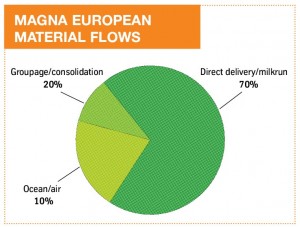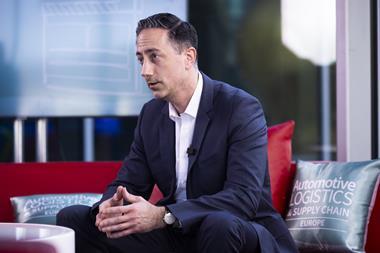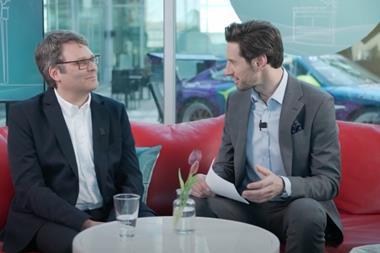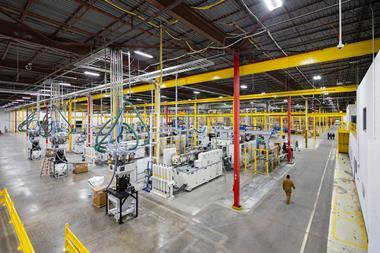Magna Logistics Europe has increasingly taken a more integrated approach to engineering logistics across the tier supplier’s massive European network, including rolling out IT tools and concepts developed at contract manufacturing unit, Magna Steyr
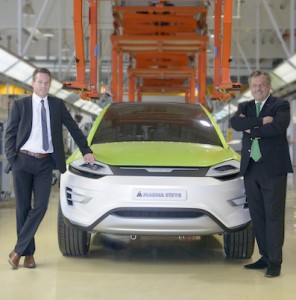
Magna International, one of the world’s largest tier one suppliers, has roots in Europe that go back a century, even though it has existed in name here for only 25 years. Frank Stronach, the company’s founder, emigrated from Austria to Canada, where he started the business in the 1950s; in a reverse migration, he expanded to Europe in the 1980s, largely through acquisition. In western Europe today, the company has 86 production and 38 engineering locations.
Here, Magna’s history of incorporated brands is still visible: Chrysler-blue rooftops remain on several buildings at its plant in Graz, in the Austrian state of Styria, leftover from a joint venture with then DaimlerChrysler and Austria’s historic industrial conglomerate, Steyr-Daimler-Puch, long since absorbed into Magna Steyr. Magna International has five more groups besides Magna Steyr, covering exteriors and interiors, powertrains (including electronics), seating systems, body, and mirrors and closures.
As well as buyouts, Magna has reflected the changing shape of the automotive sector with new locations in eastern Europe, where the company now has 36 plants, including five in Russia. Across Europe, Russia and South Africa, Magna has grown from having 69 plants in 2005 to 124 today.
Magna’s European supply chain evidences this evolution, including a strong powertrain and component base in central Europe, as well as a sweeping network mirroring carmakers’ global platform and module production strategies, with supply locations from Puebla, Mexico to Russian industrial centres like Nizhny Novgorod and in Changchun, China.
“The platform strategies of our customers are increasing Magna’s complexity because we have to control a global supply chain with more sea freight and global material flows,” says Jörg Blechinger, director of Magna Logistics Europe (MLE), the central logistics engineering and planning department of Magna International Europe.
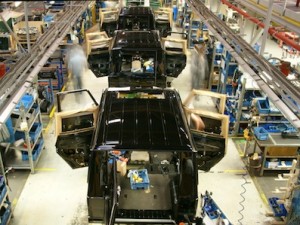
The impacts are felt across Magna’s inbound and outbound flows. According to Michael Druml, executive director of global supply chain management at Magna Steyr, a contract manufacturing and engineering division that has played an influential role in Magna’s European logistics management, the challenge for tier one suppliers is that even if they follow carmakers to locations like Russia, tier two and three suppliers are slower to localise.
“We have to go to global locations, otherwise we risk losing the business, but the sub-suppliers cannot always afford to follow us,” says Druml. “This makes supplier development so important for us, and a huge part of that is about logistics systems and processes.”
The Russian supply chain is a prime example of this rising complexity. To serve its plants there, Magna Logistics Europe has set up a consolidation centre in Veracruz, Mexico. From here material moves by ocean to German ports such as Bremen and Hamburg, and to St Petersburg. MLE has also set up a crossdock at Chemnitz, in eastern Germany, which consolidates Russian-bound material for delivery by truck.
In total, about 10% of Magna’s European-controlled material moves by sea or air freight. “We have global consolidation centres that move material out of Europe to South Africa, Asia and North America,” says Blechinger. “We are also working on a centre in China where we will bundle material for European plants.”
Druml points to a shift eastward for Magna and Magna Steyr. “We’re seeing more potential logistics hubs in the east and the south,” he says. “We also expect further development of southern ports, such as [Slovenia’s] Koper, particularly with the planned expansion of the Adriatic belt for rail freight as part of the EU’s TEN-T network.”
Going for world-class logistics
Magna’s complexity isn’t just a product of a global supply chain. Druml, who used to be responsible for importing 130 containers daily to assembly Chrysler vehicles in Graz, says that just-in-sequence local supply can even be a greater risk than sea freight. “If a sequence truck has an accident in front of the plant, you could stop the line,” he says. “If the vessel in Mexico gets held up, you still have buffer stock and air freight.”
Other global supply chain trends are making logistics even more important for tier suppliers. As product cycles shorten and competition intensifies, there is more pressure to reduce inventory and lower costs. With parts increasingly standardised in modular platforms, the role of logistics in differentiating supplier performance and cost is now greater than ever.
Jörg Blechinger, Magna Logistics Europe
Magna has responded to these demands in Europe by strengthening its logistics systems and by taking a more centralised view of the supply chain. One of MLE’s most important tools, for example, is a database that consolidates the complete flows of more than 100 plants. Plant ERP systems, logistics-specific planning and purchasing tools and around 200 logistics providers feed information to the database. According to Blechinger, the systems have helped Magna reduce planning times by up to 50%.
“Our customers expect a high flexibility in supply chain scenarios, given the frequent rotation of ramp-ups. We can react very quickly to an RFQ [request for quote],” he says. “In our planning tool we have a reference bill of materials, for example, so if a customer wants a quotation for a front-end module, he gets it quickly, with logistics costs accurately reflected.”
Along with flexibility and data transparency, the potential for logistics cost savings across Magna’s European operations is vast, given its large transport spend. Druml and Blechinger point to engineering and planning as the main drivers to lower cost, with numerous standardisation projects underway, including in packaging and data collection. The company is also exploring the rollout of a Magna Steyr-developed transport management system and more use of smartphone and tablet technology. It is also trying out new concepts for on-site logistics sorting and sequencing centres. “At Magna our production follows ‘World Class Manufacturing’ principles for lean and continuous improvement,” says Blechinger. “Therefore we are also aiming for world-class logistics.”
From decentralised innovation to strategic sharing
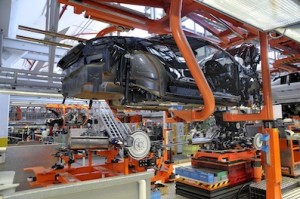
Magna has engineering capabilities for nearly every component of the supply chain, from plastic mould injection parts to mirrors, seats, doors, chassis, engines and fully assembled vehicles. Magna Steyr, for example, not only builds vehicles and chassis for the likes of Daimler, BMW and Peugeot in Graz, the division produces its own roof systems, battery packs and fuel tanks in North America, central and eastern Europe and Asia.
Magna is thus a sprawling dynasty of sorts with many entities and overlapping product expertise. Like many large tier suppliers, it operates across different systems and standards from ERP to packaging. It also has a decentralised organisational structure, with plant managers responsible for a large share of purchasing, production and logistics.
That decentralisation has not necessarily been to Magna’s disadvantage. Many of the company’s plants and divisions have become centres of innovation for logistics. About 50km east of Graz, for example, a Magna plant in Ilz has developed and built a logistics centre, owned and operated by Austrian logistics firm Temmel, that sequences and sorts just-in-time parts for Ilz’s 33 assembly lines and consolidates material for two other Magna plants in the region.
– Michael Druml, Magna Steyr
Magna Steyr is another strong source of logistics competency. The operating unit has an integrated approach to purchasing and supplier management, with logistics, global sourcing and supplier development (including delivery performance) combined under Druml. Magna Steyr has also developed a number of systems that are being implemented across other Magna International Europe plants, including its Transport Management Module (TMM). The division was one of the first global suppliers to enter the Russian market when it worked with Gaz and Chrysler to produce the Siber, in Nizhny Novgorod, in 2008. It has since served as a knowledge centre for the wider Russian market, including forming a joint venture with Russian contract OEM Avtotor to develop production clusters in Kaliningrad and Nizhny Novgorod. (Click here for more on Magna Steyr.) 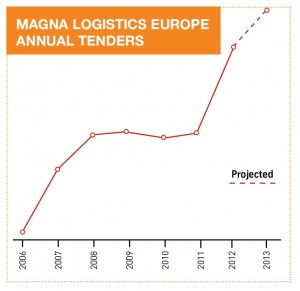
However, in recent years Magna has taken a more strategic approach to coordinating its European logistics network. In 2005, Magna Logistics Europe began as a project (originally under the auspices of Magna Steyr) to standardise logistics systems and tariffs, as well as to promote best practice across the group. Blechinger took the lead, having previously worked in various logistics projects for Magna Steyr under Druml, and has since helped build MLE from a project initiative into a strong central team working across most European Magna plants in various logistics design, purchasing and performance-auditing roles.
MLE is still evolving as an organisation; it looks primarily at bundling systems and volume across plants, including groupage, sea and air freight, but it has grown in scale with Magna’s European presence and the rising cost of logistics. In 2006, for example, MLE ran just two tenders representing a small share of Magna’s transport budget. Last year, the team held 99 tenders, with the euro amount coordinated centrally (plants still do the final contract with providers) growing nearly sevenfold in six years.
In the first four months of 2013 alone, MLE ran more than 60 tenders and expects the centrally planned logistics spend to rise another 60% compared to 2012 (see table above). Russia represents the biggest share that MLE has planned and procured, but the growth has been across Europe. “This strongly increasing central spend is the best sign for me that Magna’s European plants accept and see the benefits of our organisation,” says Blechinger.
Engineering more than a big budget
Striking a balance between what is done in central departments and what is done locally is delicate, particularly in such a sprawling organisation. Plants,especially the larger ones, generally retain responsibility for procuring their inbound direct delivery and milkrun routes. The Magna Steyr plant in Graz, for example, receives about 85% of its freight by full truckload or milkrun (compared to a Magna average of 70% in Europe), which the plant arranges itself; its 15% groupage freight is arranged through MLE. This freight, along with Magna Steyr’s other locations in Europe, was recently part of a 75-plant-wide MLE tender for groupage transport originating out of Germany, the Czech Republic and Poland.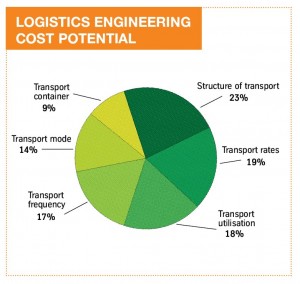
If requested, MLE will also engineer a plant’s complete supply chain. In some cases that has included running a tender and helping the plant choose anything from truck shuttle to material handling logistics providers.
For Blechinger, the ability to engineer the entire network is an important strength for MLE, regardless of whether it is the plant or a central organisation that does the purchasing. Druml points to a study, which Magna’s experience has confirmed, that shows the influencers of total logistics costs. The leading factor is the structure of transport, which makes up 23%, while transport utilisation (18%) and frequency (17%) also score highly. Transport rates alone have only a 19% impact.
“When many people talk about transport costs, they talk about pricing,” says Druml. “However, if we look at the total potential to reduce costs, mileage is only 19%, which means more than 80% of the possibilities are in engineering.”
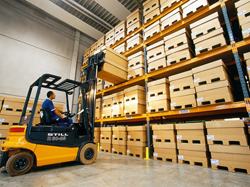 Jörg Blechinger and Michael Druml note that there is a trend to bundle high frequency material flows near or at a plant for its different assembly lines. Magna has recently introduced such a system at the Temmel Logistics Centre (TLC) in Ilz, some 50km east of Graz, which opened in 2012.
Jörg Blechinger and Michael Druml note that there is a trend to bundle high frequency material flows near or at a plant for its different assembly lines. Magna has recently introduced such a system at the Temmel Logistics Centre (TLC) in Ilz, some 50km east of Graz, which opened in 2012.
Commissioned and constructed in four months during 2011, the 15,000-square-metre warehouse sequences parts for the Magna plant’s 33 assembly lines. The TLC also handles parts for other Magna plants in Lannach, 60km to the southwest from Ilz, and Albersdorf, 25km away. The TLC receives and dispatches around 60 trucks per day.
The TLC is on the plant complex, but is owned and operated by Temmel, an Austrian firm specialising in just-in-sequence logistics, warehousing, assembly services and line feeding. Magna operates the in-plant logistics at Ilz with in-house staff in a close collaboration with Temmel. The TLC is fully integrated into Magna’s SAP system, receiving several thousand transport orders each day, according to Oliver Strallhofer, TLC Temmel logistics manager. Temmel employees sequence parts and prepare boxes; Magna employees drive into the TLC on tugger trains, which Temmel loads for lineside delivery.
The process is controlled by an electronic kanban system; Magna tugger drivers follow a strict route and scan a card when supplies are low, which signals the TLC to pack and deliver boxes. According to Jürgen Münch, manager of lean manufacturing methods and processes at Magna, the TLC follows three different packaging methods: one for steel rack and big boxes that hold die-cast housings; a second for special parts in bespoke boxes, such as shafts and gear wheels; and finally one for small boxes, with parts such as screws and bearings.
The TLC has a separate area where Magna does quality testing, as well as space for empty containers. There is a specially built machine to wash reusable containers, as well as a machine for conserved parts and packaging. About 10-15 trucks leave the TLC each day with empty boxes.
Open-book supplier management
Magna collects data on the TLC’s logistics performance and displays its KPI in the warehouse. “We work on an open-book pricing method, but we also must meet daily targets,” says Strallhofer. “We have very small delivery windows and since the third quarter of 2012, our delivery performance has exceeded 99%.”
Münch says that before the TLC, the plants relied on satellite warehouses with several transport providers between them. The TLC saves logistics costs and increases flexibility in production, he adds. According to Hagen Temmel, the company’s 50% owner, the TLC is a first of its kind for Temmel, which also has a facility in Graz assembling bumpers and wheels. “This has taken our operations to a new level of logistics complexity,” he says.
Münch reveals that in 2014 Temmel will take over logistics control and in-plant materials handling for another Magna plant. The operation will involve 70 employees working up to 21 shifts per week.
From forward planning to daily execution
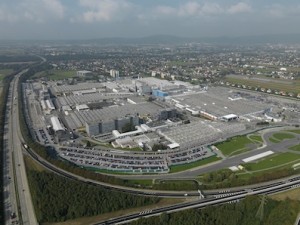
Blechinger is careful about overstepping MLE’s boundaries. “I would never interfere with operational processes that belong to the plant, such as material call-offs and in-plant logistics,” he says. “For freight procurement, on the other hand, the plant would not have the broad view of the network that a central organisation has.”
However, MLE is becoming an increasingly operative organisation. IT systems and packaging are notable areas. Magna has more than 20 different ERP systems in Europe, and implementing interfaces and shared systems, such as Magna Steyr’s TMM, would have benefits.
MLE’s focus on planning and design also leads to operational influence for transport. MLE’s planning tools help engineer routes and determine the best order and delivery frequencies for the plants to follow. “The best planning is useless if you don’t implement it in the ERP system,” notes Blechinger. “The key is to level out the deliveries during the week, which include time windows for groupage, and also direct delivery and milkruns. Based on the supply chain design, we will adjust a plant’s order parameters in the system.”
Magna also has a variety of pallet and rack standards. This year, MLE created a packaging planning team to study standardising all kinds of packaging. It has recently implemented a packaging-planning tool – again developed by Magna Steyr – that informs the design and implementation of equipment and empty container management. Magna is using the tool to engineer the packaging for its Russian projects and will roll it out across all European plants.
MLE’s operational input is strongest at the start of a project, with the day-to-day management and deliveries controlled by the plant. The Graz plant or other high-volume factories in Styria usually have the resources to manage these operations efficiently, including making rolling changes. For example, Magna Steyr’s TMM tool incorporates inbound and outbound transport, part and container dispatch, freight control, premium freight management and inventory. The system also interfaces with the plant’s truck transponder and dock call-off systems. “It is one of the few systems in the market that is really an integrated management tool,” says Druml. “We start from the planning, and we can move through optimisation of routes, freight payments and empty container handling.”
Druml says Magna Steyr’s route and delivery planning is adjusted every week in principle; however, his team monitors cube utilisation daily. “We can react immediately,” says Druml.
MLE is working on rolling out this system across more Magna plants. Already, Magna Steyr and a Magna Powertrain plant in Lannach, Austria are using TMM. The other plants are using the premium freight module, which provides a quote in less than an hour and tracks all orders online. Currently, MLE monitors the network and encourages plants to make changes where it sees potential to improve truck utilisation. Blechinger points to a plant’s shift model as one of the main factors, as it influences how often and for how long it receives deliveries. A move to a more dynamic operational planning with TMM, which would start with an OEM’s production changes and extend through Magna’s sub-suppliers, would require MLE to get closer to the day-to-day operations of plants than it already is.
“This would be a big potential for MLE to make huge improvements in cube utilisation,” he says. “We have to put a strong focus on the operational steering of the network, including pickup management based on the call-off of our customers, truck utilisation, tracking and tracing the material until the truck arrives at the dock of our plants. We then have to do the same for the container returns process.”
Nurturing logistics and supplier development
Along with logistics planning and operations, MLE is focused on logistics provider development. It does performance and financial ratings for potential and active service providers before tenders begin to assess their strengths, profitability, strategic direction and key-account management structure (or lack thereof).
Sea freight makes up 5-10% of Magna’s European volume, but there is not much intermodal logistics otherwise. Magna Steyr receives a few containers per day at Graz. It was different back when it produced Chrysler models like the Jeep Grand Cherokee and Voyager, with about 130 containers arriving every day from North America. Magna Steyr also used to run dedicated trains from Germany.
Should the situation change, Graz has a strong intermodal advantage with the development of the Cargo Centre Graz, which was built ten years ago as public-private partnership between the regional state government of Styria and a number of logistics companies.
The site has direct motorway access and a railway terminal operated by the Styrian regional railway, which connects north to Germany and to the south, including the port of Koper. The terminal has 120,000 square metres of warehousing where major logistics companies, including DHL, Wenzel Logistics, DB Schenker and Panalpina, along with a large German supermarket chain, carry out storage and packing operations. Around 300 trucks and 10-12 block trains arrive at the facility every day with general cargo (very little of it currently for Magna). The centre has recently added a north terminal, where Dachser has a crossdock. Cargo Centre Graz also has a fire department and security control tower on site.
 While the Magna cargo moving through the centre is small today, it used to be a dominant customer with the Chrysler container volume. Hödlmayr, an Austrian-based vehicle logistics providers, also used to have space at the centre for moving vehicles by rail. The centre has capacity for about 150,000 containers per year, but it is currently handling closer to 65,000.
While the Magna cargo moving through the centre is small today, it used to be a dominant customer with the Chrysler container volume. Hödlmayr, an Austrian-based vehicle logistics providers, also used to have space at the centre for moving vehicles by rail. The centre has capacity for about 150,000 containers per year, but it is currently handling closer to 65,000.
While its model and supply mix is the main reason Magna Steyr has so little intermodal transport today, Druml says the industry’s general lack of intermodal is partly down to an unwillingness among providers and manufacturers to share risk.
“Everybody wants it and understands that it is a green initiative, but nobody is willing to take a real risk,” he says. “As a shipper, why should all the risk be on our side?”
Things could change with the planned development of a dedicated rail freight corridor with funding support from the European Union, particularly a link that would strengthen the connection between central Europe and the Adriatic – something that officials at the Cargo Centre Graz also anticipate will lead to more multimodal freight at its terminals.
Magna operates an area-forwarding network in most of Europe, which emphasises regional strengths rather than the integrated approach of a ‘lead logistics provider’ or ‘fourth party provider’. As such, Blechinger believes it is valuable to understand the expansion plans of providers. “It is important to know the strategy of a service provider,” he says.
MLE has nurtured diversification of Magna’s provider base. In 2005, the supplier worked with around 150 providers in Europe. Although Blechinger admits that his team originally thought it would consolidate this number, Magna now works with 200 providers. “We have learned that many service providers have strengths in different regions and transport modes, and we like to utilise those strengths,” he explains.
Blechinger adds that it is important to challenge providers on innovation, which he and Druml find them to be lacking. MLE has begun a series of logistics days, which bring together logistics managers and providers from across the network to discuss future business and concepts. This autumn, for the first time, the MLE day will feature an innovation award based on provider-submitted concepts. “It’s a chance for our providers to get creative, and also to potentially gain more business from us,” he says.
The next generation
Provider development is in part another influence from Druml and his supply chain organisation at Magna Steyr, which combines elements of material purchasing – particularly those components engineered and procured by Magna Steyr directly – and logistics. Supplier development goes across all elements of performance, cost and risk for logistics as well as material suppliers. Magna Steyr’s SCM consultancy department, for example, will go to supplier plants, if necessary, to help improve supply chain breakdowns. This team also supports MLE in some instances.
“It is not enough to just rate a supplier by PPMs [problem parts per million]. You have to look at logistics performance as well,” says Druml. “This helps not only in operational performance, but also in the sourcing process.”
Druml believes that to improve logistics performance, manufacturers like Magna Steyr, as well as organisations like Magna Logistics Europe, should go deeper into the tier supply chain. “We have to bring lean processes to the tier two and tier three level, and not just push inventory back onto other suppliers or providers,” he says. “True lean means that the next tier suppliers are producing to our schedule in synchronisation.”
Blechinger agrees, and sees a deeper integration of Magna’s supply chain as a must. Both he and Druml emphasise the importance of supplier development in eastern Europe and Russia, where improving logistics performance among lower tiers is part of supply base localisation. Blechinger also sees the on-going development of Magna’s own logistics organisation in these regions as vital.
“We have to train the people, including getting them used to our ERP systems. We need to develop young, motivated Russian people,” he says.
Above all, Blechinger is keen for MLE to be a forward-looking organisation. He calls for more training and education, as he believes logistics managers will need to have a broader understanding of complex supply concepts and IT systems to meet future logistics needs.
Blechinger wants Magna closer to universities so that they might better understand what manufacturers need from future graduates. While he points to programmes that Magna sponsors through the Frank Stronach Institute in Graz, which focuses on technical degrees like engineering, he would like to see programmes that include logistics.
“There will be tremendous changes in the future. By 2030, we’ll see a computer with the capacity of a human brain; by 2050, there will be computers with the capacity of all humans on earth,” Blechinger says. “Nobody has to fear it, but we need to see it as a chance, and develop our people for the needs of the future.”

























![Global[1]](https://d3n5uof8vony13.cloudfront.net/Pictures/web/a/d/s/global1_726550.svgz)





